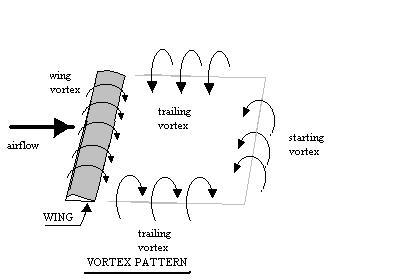Many wonder, since air is invisible, how it can support an airplane. Even though it is invisible, air is stuff. There are many examples. Feel the wind and watch the wind blow snow, leaves and trees, and the stuff that is air becomes more apparent. The terrible distruction of hurricanes and tornadoes is tragically clear evidence that air contains alot of stuff, stuff that can apply a great deal of pressure, easily enough to lift an airplace.
There are many explanations of How Airplanes Fly in books, museums, flying lesson material and other sources. Most rely on the relation between fluid velocity and fluid pressure given many years ago (in 1738) by Daniel Bernoulli. That relation is of fundamental importance in aeronautics and is called Bernoulli's Theorem. Important in an explanation of flight, Bernoulli's Theorem states that: where the velocity is higher, the pressure is smaller; and where the velocity is lower, the pressure is larger.
Since the velocity above the wing is higher than the velocity below the wing, it follows directly from Bernoulli's Theorem that airplane wings provide lift. Most explanations rely on this relation to explain how things fly. Where many have difficulty is in explaining why the velocity is higher above the wing then below the wing.
For example, several Federal Agencies have presented in flying lesson material that the velocity is higher on the top of the wing because, for an airfoil shape, the air particles have further to go to match up at the trailing edge with particles on the bottom of the wing and therefore they must go faster. It is well established that the air particles do not match up at the trailing edge. If they did, how could an airplane fly upside down, as is often seen at air shows. Unfortunately, there are also a number of other less-than-correct explanations.
Why is the velocity above the wing higher than below the wing?
To explain why the velocity is higher above the wing than below, it may help to recollect some common observations. When rowing a boat or paddling a canoe one often notices the swirls that the oars or paddles make in the water. These swirls occur off the relatively sharp edge of the oar or paddle.
When fluid flow, air or water, is around a relatively sharp edge, or even when two different flow rates meet, swirls or VORTICES form. It is an important natural phenomenon. Similarly a vortex is formed by the sharp trailing edge of an airfoil. This vortex is termed the starting vortex.
Since every action has an equal and opposite re-action, when a vortex starts, behind an airfoil, the equal and opposite reaction is a vortex in the opposite direction around the airfoil. Thus, there are two velocities that affect the pressure on the airfoil: 1) the velocity of the airfoil through the air, and 2) the vortex or circulation around the airfoil. Above an airfoil, the velocity through the air and the circulation are in the same direction and are additive. Below the airfoil the circulation is subtracted from the velocity through the air. Consequently, above the airfoil the velocity is higher and, from Bernoulli's Theorem, the pressure is lower. Below the airfoil there is a lower velocity and higher pressure. The pressure differential produces lift. The lift is proportional to the velocity through the air and the magnitude of the circulation. The circulation increases with the angle of attack of the airfoil.

Without going into detail, theory and visual flow observations both confirm that the starting vortex detaches from the airfoil. The airfoil vortex is connected to the starting vortex by two trailing vortices, one from each wing tip. Visualization of this vortex pattern is important to pilots in avoiding vortices of other airplanes, particularly larger ones.

Note: "How Airplanes Fly" briefly describes the aerodynamics known and practiced by Aeronautical Engineers. I have a Masters Degree and Professional Degree in Aeronautical Engineering from the California Institute of Technology. I learned and practiced these same principles, did research in aeronautics and helped design advanced airplanes that flew.
References:
1) Millikan, Clark B., Aerodynamics of the Airplane , Wiley, New York, 1941
2) Van Sickle, Neil D., Modern Airmanship , D. Van Nostrand, Princeton, New Jersey, 1957
3) Von Kármán, Theodor, Aerodynamics , Cornell University Press, Ithaca, N.Y., 1955